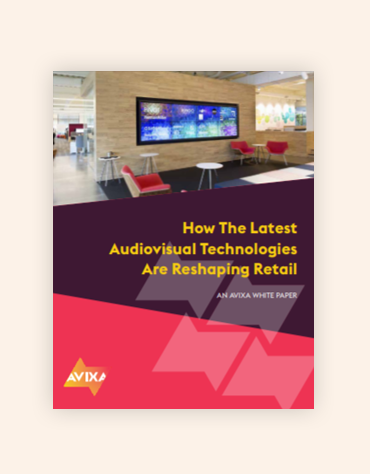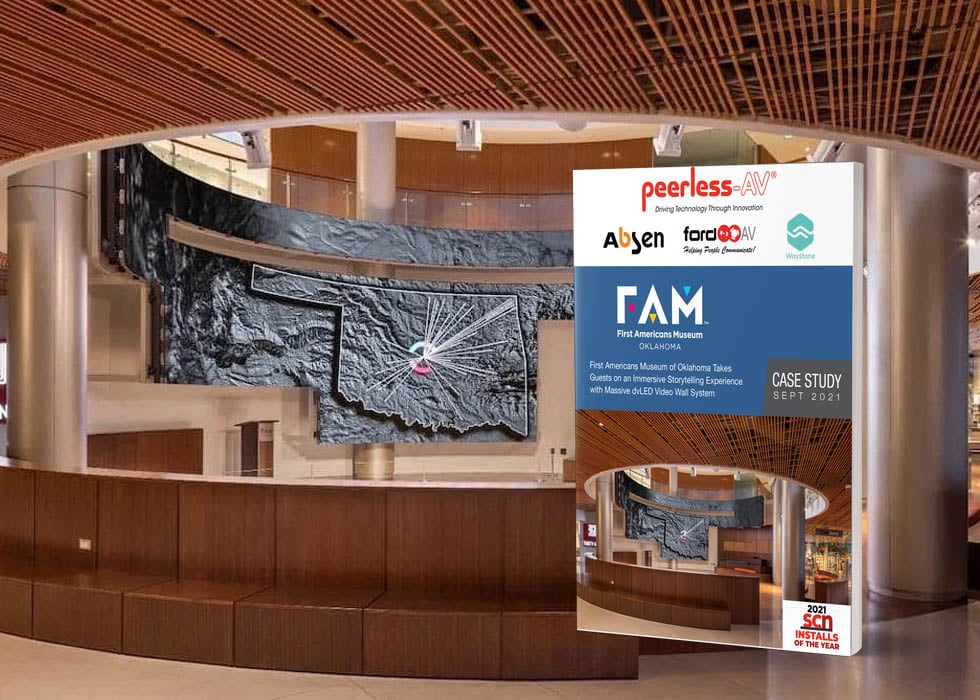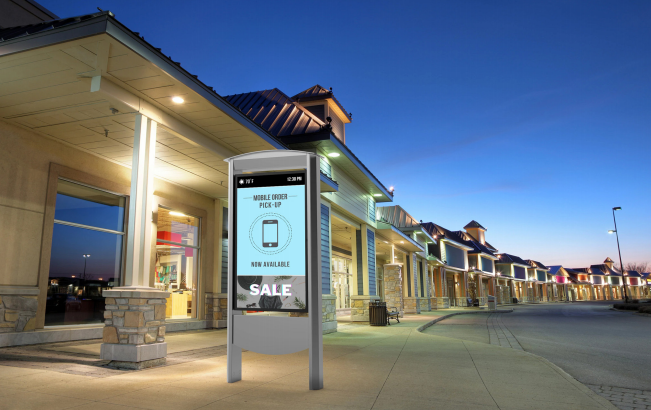How the Latest Audiovisual Technologies are Reshaping Retail
What do fast food restaurants, auto dealerships, electronic games manufacturers, and interior design companies have in common? They’re all part of a big growth market in retail for advanced AV solutions, ranging from so-called “experience” stores affiliated with sports leagues and entertainers to interactive spaces that allow customers to try out the latest video game, sip a latte while virtually accessorizing a car, or visualize a new layout for their office. (And post a tweet while polishing off a taco or two!)
If you want to know what the future of retail looks like, walk the Strip in Las Vegas or take a stroll through Times Square, where you’ll see storefronts bristling with big, bright electronic signs and video displays. Inside, you’ll find interactive video kiosks to guide customers to products and services. You’ll likely hear multichannel sound of a major sporting event or a stadium concert playing in the background. And you may even encounter virtual and augmented reality experiences that let customers step into another world.
All of these experiences are enabled by the latest advancements in video and audio technology, signal management and distribution, user interfaces, and control systems. These retail experiences are often characterized by supersized displays and spatial sound that draw in customers and also provide a mix of entertainment, custom advertising, and social media that’s all served up over fast networks.
Nowadays, it’s simply not enough to rely on static displays of goods stacked on shelves. Customers want more entertainment and engagement while they’re considering a purchase, thanks to the proliferation of inexpensive large-screen televisions in their homes; smartphones and tablets connected to Facebook, Twitter, and Instagram; and powerful gaming consoles
Consider interior design, where powerful software tools can render lifelike views of living and working spaces using drag-and-drop interfaces and virtual 360-degree views. Large interactive video screens help bring these designs to life and facilitate group participation in the design process. The larger the screen, the easier it is to visualize an interior design and get buy-in from the client
Have you visited a waiting room in an automobile dealership lately? What was once a rather sterile space with uncomfortable chairs, bare walls, and a vending machine has evolved into plush living rooms with kitchenettes and drinks, free Wi-Fi, USB ports for charging, coffee bars, and large video screens at the center of everything.
The same thing is happening in a growing number of fast food restaurants — instead of staring at a wall, customers are entertained by content on supersized video screens while downing their combo meal. They may even be able to connect to their favorite social media platform and post a review to Yelp on that same screen before they’ve finished.
When it comes to purchases of video games, it’s a whole new playing field for retail. Instead of crowded stores with shelves stacked to the ceiling, the winning concept is large open spaces with ample lighting and plenty of room for customers to put on a pair of headphones and pick up a controller to play the latest video game on supersized screens — maybe even with players in another store, at home, or overseas.
In each of these cases, the level of customer engagement has increased by several magnitudes, and assuming the product or service purchased meets expectations, customer satisfaction has likely increased by the same amount. All it takes is some creativity (getting rid of the “same old, same old” mentality), which is enabled by a suite of next-generation powerful, flexible, and cost-effective AV hardware and software products.
Here are some examples of how retailers are upping their game with cutting-edge AV solutions.
Albrecht Auto Group: Videowall Impact
In the highly competitive automobile industry, dealerships need to provide an elevated experience to stand out from competitors, in particular those selling upscale marques. They want to foster a strong, intimate customer-to-brand affinity by building brand reputation, differentiation, and loyalty, resulting in repeat business. And because the majority of customer interaction with any dealership takes place in the service department, that’s the best place to start.
The goal is to create a customer lounge that offers an enticing, relaxing, and congenial environment to pass the time. (Studies show that while they wait, service customers frequently visit the show room, creating opportunities for future sales.) One way to create that environment is to install a video entertainment system that will engage, entertain, and inform. That’s precisely what the Albrecht Auto Group did. Albrecht is an Infiniti, Nissan, and Toyota dealer with multiple locations serving New England. Its Toyota dealership in Woburn, Massachusetts, has been equipped with a new customer lounge designed for comfort and convenience, centered around a 3 x 3 videowall array of 49-inch LCD displays.
The videowall depicts a wide variety of dealer-customized content including local and national broadcasts, news, and sporting events; Toyota advertising; dealership promotions; video of cars being picked up; service and repair status; time-to-completion information; and video and written customer testimonials. The dealership also uses the videowall to promote various aspects of the dealership: its offering of auto accessories, gifts, auto parts, and maintenance and repair services.
In addition to signals from cable boxes, a PC-based media server, and multiple computer feeds, the wall’s processor streams live video from cameras in the service department. The wall processor offers the flexibility to display content in any size, anywhere on the videowall surface. Display layouts can be changed instantly to enhance viewer attention and interest, using a touchscreen tablet PC to select preset display layouts, switch and route sources, and size and position windows on the fly
Razer: Video Galleries, Plus Wayfinding
Interest in video gaming is at an all-time high and constitutes a multibillion-dollar business. Razer Inc. describes itself as “the world’s leading lifestyle brand for gamers” and designs and builds a huge gamer-focused ecosystem of hardware, software, and services. With a fan base that spans every continent and recognition as the leading brand for gamers in the United States, Europe, and China, Razer decided to enhance the connectivity, aesthetic, and capabilities of digital signage in its flagship stores and corporate offices across three time zones, two continents, and five countries.
Two locations in the massive global AV upgrade project were the new RazerStore San Francisco and Razer’s U.S.A. office in Irvine, California, where Razer sought to showcase its high-quality content in both unique installation environments. The project faced some challenges: The environments were exposed to high levels of ambient and internal light, particularly in the San Francisco location, where the displays would be window-facing. The San Francisco store was also located in a mall, therefore, the installation crew had to work outside the mall’s regular operating schedule late at night or early in the morning.
Prior to the renovations, Razer’s U.S. locations used consumer-grade displays. During the decision-making process, Razer decided to switch to commercial-grade AV displays for the upgrades, attaining the brightness levels and image quality it needed to combat high ambient and instore lighting levels. More importantly, these displays featured shorter lag times than those of consumer displays — an absolute must for competitive gaming.
Razer installed two 1 x 6 videowall galleries composed of 43-inch LCD monitors in the lobby to communicate key information to employees, business partners, and visitors to the location. The installation team also mounted 16 ultrathin-bezel 55-inch LCD monitors to create a huge 4 x 4 videowall for an immersive gaming experience for customers of the RazerStore San Francisco. Additional stand-alone 55-inch monitors meet the need for wayfinding and promotional purposes throughout the RazerStore.
To manage the displays internationally, Razer operates two remote servers, one in Singapore and one in China. Additional hardware and software enable Razer staff to seamlessly manage, edit, and display content, regardless of location. The company has received a flood of positive feedback from visitors and RazerStore San Francisco is touted by key gaming media and influencers, who point to the videowall installation as an impressive feature of the store. According to management, there has been a noticeable increase in foot traffic, consumer engagement, and sales since the project’s completion.
Tacho Bell Vegas: Live Camera Feeds
Taco Bell is one of the largest fast food chains in North America. Now, it’s expanding in a bold, innovative way with the launch of a new “Cantina” restaurant concept on the Las Vegas Strip. The Cantina’s inventive interior combines advanced technology and cool design using a large videowall for a fun, social dining experience. You might say that Taco Bell is simply “keeping up with the Joneses,” given the unbelievable diversity and number of digital signs and video screens on the Strip.
The Cantina’s massive 14-feet by 8-feet videowall is arranged in a 4 x 4 array of 27-inch LCD screens. The videowall processor consolidates disparate sources and displays them on the wall array with as many as 60 user-customizable presets. The processor’s ability to display imagery in windows of any size, anywhere on the videowall canvas, and seamlessly change layouts on the fly enhances the entertainment experience. It’s also intuitive for restaurant management to operate and is rated for 24/7 operation.
At its grand opening, the Taco Bell Cantina management was ecstatic with the results. This immense display lets patrons throughout the restaurant watch broadcasts, sports, and news events, as well as catch up on social media posts while dining, which may be a first for a fast food chain. Video sources include broadcast receivers, live camera feeds from the Strip, and PCs providing social media content from a variety of platforms.
Pivot Interiors: Engaging Visitors, Supporting Productivity
For more than 40 years, Pivot Interiors, which specializes in office furniture services, has been creating environments that inspire innovation, foster collaboration, and increase productivity. Its workspace designs feature leading-edge products that make use of unique textures and a wide variety of materials specifically designed for busy offices.
At its new showroom in Santa Clara, California, Pivot relies on advanced technologies to convey the company’s brand and values, showcase memorable projects, help clients plan their office spaces, train Pivot employees, and engage visitors. In what the company calls the plaza area of the showroom, which is the central focus of the showroom space, a 4 x 2 videowall composed of eight 46-inch LCD displays was installed, creating a videowall nearly 100 square feet in size.
The videowall is used to welcome clients and visitors and also serves as a platform for both client meetings and for Pivot’s after-hours entertainment and events. During business-day usage, the videowall hosts presentations to clients, including live videoconferences with other Pivot offices. After business hours, it supports all-hands presentations for employees; videos and other entertainment; and similar content for outside visitors and organizations that rent the space for their own meetings and events.
Behind the reception area is Pivot’s main conference room, where more indepth and private client and company meetings take place. Here, two 84-inch 4K touchscreen LCD displays are set flush to a prominent wall and separated from each other by about 10 inches to accommodate a videoconferencing camera. Displayed content includes a calendar of scheduled meetings, PC-resident presentations, and a wide variety of information Pivot and clients share about projects, including floor plans, renderings, products, and materials for projects. The interactive touch capability is used to initiate a meeting, kick-off a videoconference, or enable presenters to call up details, products, or other information pertinent to a client’s project.
Two other important areas include the Pivot training room and a library. The training room is a large space designed to accommodate company meetings and training sessions using two 98- inch 4K touchscreen LCD displays for “whiteboarding” presentations with employees, showing training videos, and conducting videoconferencing meetings with employees at other locations. The library is a less formal area where employees can use a 55-inch interactive full HD LCD display to share client presentations or access websites to review new products, materials, and textures that may be considered for clients’ office projects.
In each of the cases described, advanced AV solutions were used to elevate retail experiences to a higher level, engaging customers and creating new opportunities for initial and repeat sales. Every approach was different — refined customer service, immersive shopping, social media blended with dining, and high-tech visualization — yet all four worked to increase customer satisfaction by reshaping traditional, static concepts of retailing.






